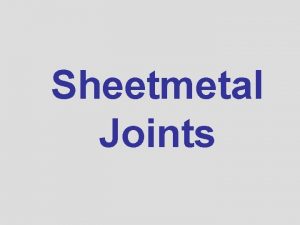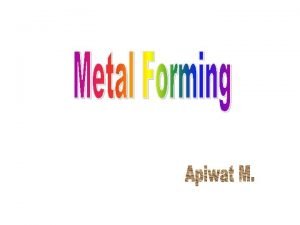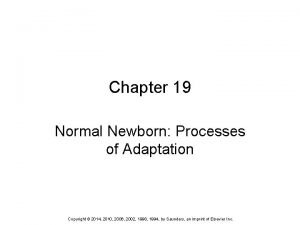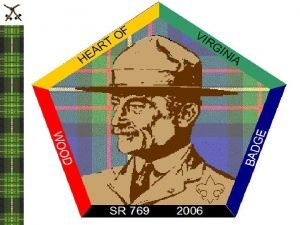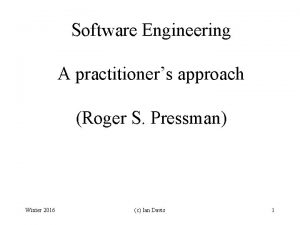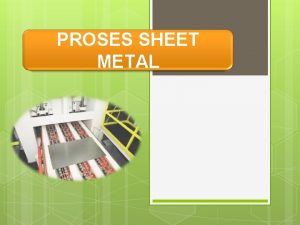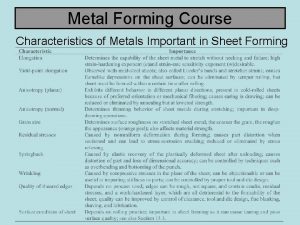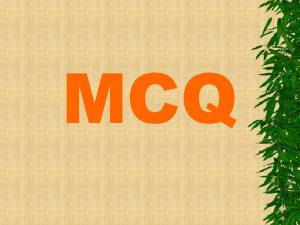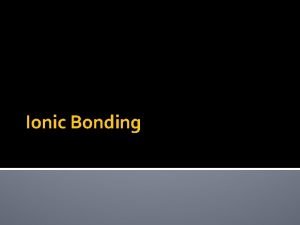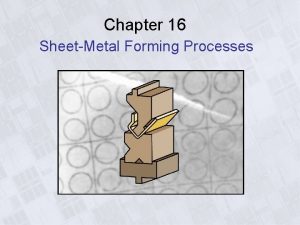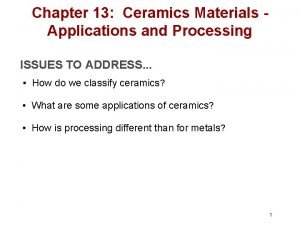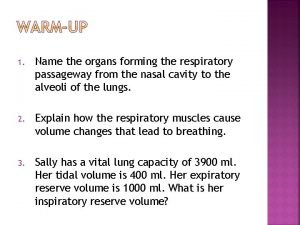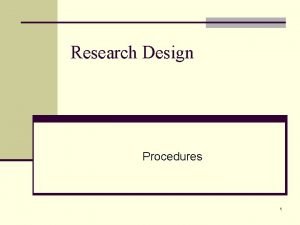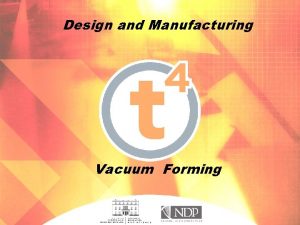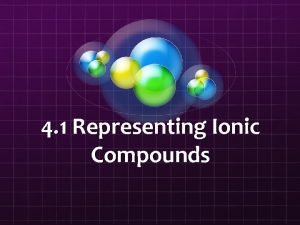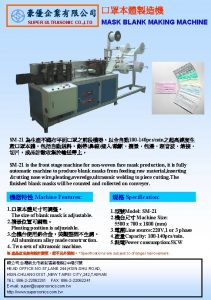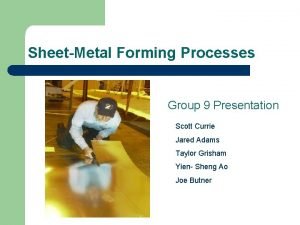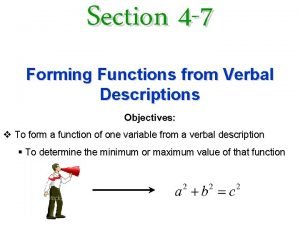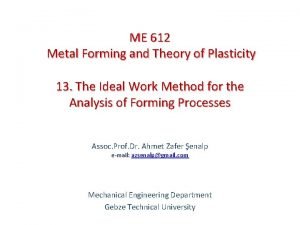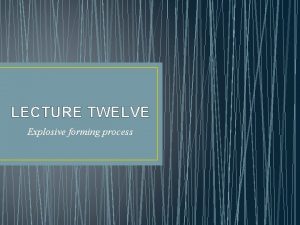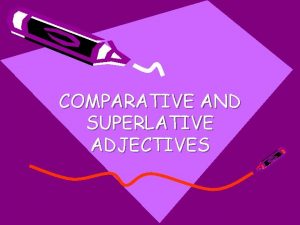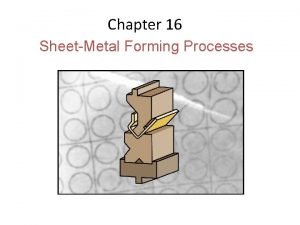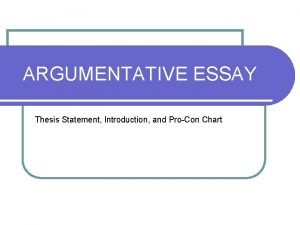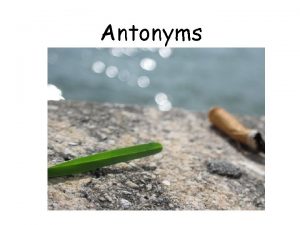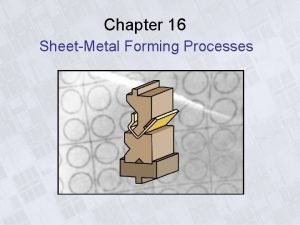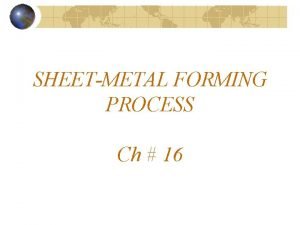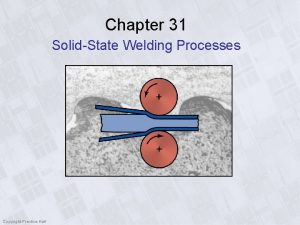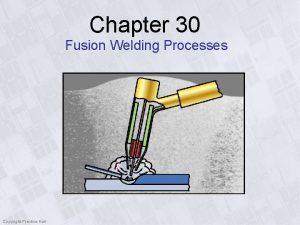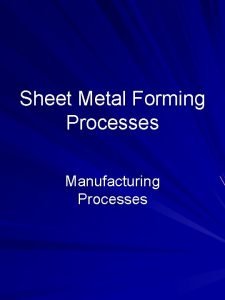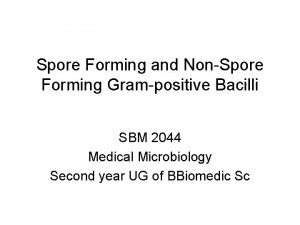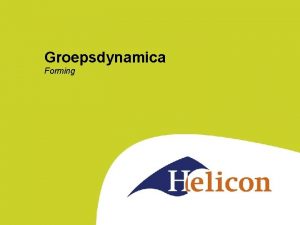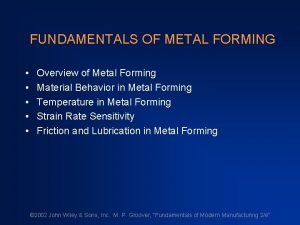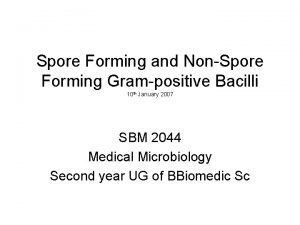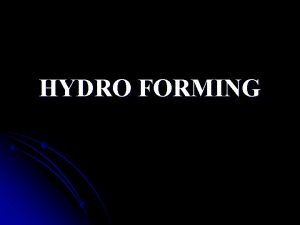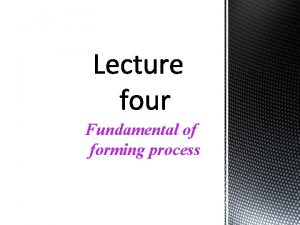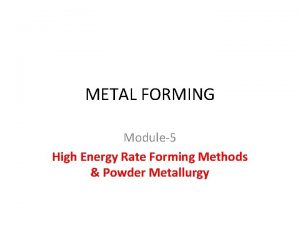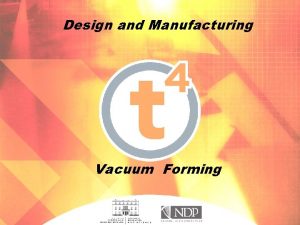Chapter 16 SheetMetal Forming Processes Copyright PrenticeHall SheetMetal









































- Slides: 41

Chapter 16 Sheet-Metal Forming Processes Copyright Prentice-Hall

Sheet-Metal Parts (a) (b) Examples of sheet-metal parts. (a) Die-formed and cut stamped parts. (b) Parts produced by spinning. Source: (a) Courtesy of Aphase II, Inc. (b) Courtesy of Hialeah Metal Spinning, Inc.

Characteristics of Sheet-Metal Forming Processes

Die-Cutting Operations (a) Punching (piercing) and blanking. (b) Examples of various diecutting operations on sheet metal.

Slitting with Rotary Knives Slitting with rotary knives. This process is similar to opening cans.

Tailor-Welded Blanks Production of an outer side panel of a car body by laser butt-welding and stamping. Source: After M. Geiger and T. Nakagawa.

Examples of Automotive Components Produced from Tailor-Welded Blanks Examples of laser butt-welded and stamped automotive-body components. Source: After M. Geiger and T. Nakagawa.

The Shaving Process Schematic illustrations of the shaving process. (a) Shaving a sheared edge. (b) Shearing and shaving combined in one stroke.

Shear Angles Examples of the use of shear angles on punches and dies.

Compound Die and Progressive Die Schematic illustrations: (a) before and (b) after blanking a common washer in a compound die. Note the separate movements of the die (for blanking) and the punch (for punching the hole in the washer). (c) Schematic illustration of making a washer in a progressive die. (d) Forming of the top piece of an aerosol spray can in a progressive die. Note that the part is attached to the strip until the last operation is completed.

Characteristics of Metals Used in Sheet-Forming

Sheet Metal (a) Yield-point elongation in a sheet-metal specimen. (b) Luder’s bands in a lowcarbon steel sheet. (c) Stretcher strains at the bottom of a steel can for household products. Source: (b) Courtesy of Caterpillar Inc.

Cupping Test and Bulge-Test (a) A cupping test (the Erichsen test) to determine the formability of sheet metals. (b) Bulge-test results on steel sheets of various widths. The specimen farthest left is subjected to, basically, simple tension. The specimen farthest right is subjected to equal biaxial stretching. Source: Courtesy of Inland Steel Company.

Forming Limit Diagram (a) Strains in deformed circular grid patterns. (b) Forming-limit diagrams (FLD) for various sheet metals. Although the major strain is always positive (stretching), the minor strain may be either positive or negative. In the lower left of the diagram, R is the normal anisotropy of the sheet, Source: After S. S Hecker and A. K. Ghosh.

Deformation and Tearing in Sheet Metal During Forming The deformation of the grid pattern and the tearing of sheet metal during forming. The major and minor axes of the circles are used to determine the coordinates on the forminglimit diagram. Source: After S. P. Keeler.

Bending Terminology Bending terminology. Note that the bend radius is measured to the inner surface of the bent part.

Effect of Elongated Inclusions (a) and (b) The effect of elongated inclusions stringers) on cracking as a function of the direction of bending with respect to the original rolling direction of the sheet. (c) Cracks on the outer surface of an aluminum strip bent to an angle of 90 degrees. Note also the narrowing of the top surface in the bend area (due to Poisson effect).

Minimum Bend Radius Relationship between R/T ratio and tensile reduction of area for sheet metals. Note that sheet metal with 50% tensile reduction of area can be bent over itself in a process like the folding of a piece of paper without cracking. Source: After J. Datsko and C. T. Yang.

Springback in Bending Springback in bending. The part tends to recover elastically after bending, and its bend radius becomes larger. Under certain conditions, it is possible for the final bend angle to be smaller than the original angle (negative springback).

Methods of Reducing or Eliminating Springback Methods of reducing or eliminating springback in bending operations. Source: After V. Cupka, T. Nakagawa, and H. Tyamoto.

Common Die-Bending Operations Bending Force Common die-bending operations showing the dieopening dimension, W, used in calculating bending forces.

Bending Operations Examples of various bending operations.

Press Brake (a) through (e) Schematic illustrations of various bending operations in a press brake. (f) Schematic illustration of a press brake. Source: Courtesy of Verson Allsteel Company.

Bead Forming (a) Bead forming with a single die. (b) and (c) Bead forming with two dies in a press brake.

Roll-Forming Process (a) Schematic illustration of the roll-forming process. (b) Examples of rollformed cross-sections. Source: (b) Courtesy of Sharon Custom Metal Forming, Inc.

Methods of Bending Tubes Methods of bending tubes. Internal mandrels or filling of tubes with particulate materials such as sand are often necessary to prevent collapse of the tubes during bending. Tubes also can be bent by a technique consisting if a stiff, helical tension spring slipped over the tube. The clearance between the OD of the tube and the ID of the spring is small, thus the tube cannot kick and the bend is uniform.

Stretch-Forming Process Schematic illustration of a stretch-forming process. Aluminum skins for aircraft can be made by this method. Source: Courtesy of Cyril Bath Co.

Can Manufacture The metal-forming processes involved in manufacturing a two-piece aluminum beverage can.

Deep-Drawing (a) Schematic illustration of the deep-drawing process on a circular sheet-metal blank. The stripper ring facilitates the removal of the formed cup from the punch. (b) Process variables in deep drawing. Except for the punch force, F, all the parameters indicated on the figure are independent variables.

Normal and Average Anisotropy Strains on a tensile-test specimen removed from a piece of sheet metal. These strains are used in determining the normal and planar anisotropy of the sheet metal.

Relationship between Average Normal Anisotropy and the Limiting Drawing Ratio The relationship between average normal anisotropy and the limiting drawing ratio for various sheet metals. Source: After M. Atkinson.

Earing and Planar Anisotropy Note: If R=0, no ears form. The height of ears increases as R increases. Earing in a drawn steel cup caused by the planar anisotropy of the sheet metal.

Hydroform Process Figure 16. 40 The hydroform (or fluid-forming) process. Note that in contrast to the ordinary deep-drawing process, the pressure in the dome forces the cup walls against the punch. The cup travels with the punch; in this way, deep drawability is improved.

Tube. Hydroforming (a) Schematic illustration of the tubehydrofroming process. (b) Example of tubehydroformed parts. Automotive exhaust and structural components, bicycle frames, and hydraulic and pneumatic fittings are produced through tube hydroforming. Source: Courtesy of Schuler Gm. BH. (b)

Conventional Spinning (a) Schematic illustration of the conventional spinning process. (b) Types of parts conventionally spun. All parts are axisymmetric.

Shear-Spinning and Tube-Spinning (a) Schematic illustration of the shear-spinning process for making conical parts. The mandrel can be shaped so that curvilinear parts can be spun. (b) and (c) Schematic illustrations of the tube-spinning process

Structures Made by Diffusion Bonding and Superplastic Forming of Sheet Metals Types of structures made by diffusion bonding and superplastic forming of sheet metals. Such structures have a high stiffness-to-weight ratio. Source: Courtesy of Rockwell International Corp.

Manufacturing Honeycomb Structures Methods of manufacturing honeycomb structures: (a) expansion process; (b) corrugation process; (c) assembling a honeycomb structure into a laminate.

Control of Defects in a Flange Control of tearing and buckling of a flange in a right angle bend. Source: Courtesy of Society of Manufacturing Engineers.

Obtaining a Sharp Radius in Bending Application of scoring or embossing to obtain a sharp inner radius in bending. Unless properly designed, these features can lead to fracture. Source: Courtesy of Society of Manufacturing Engineers.

Cost of Conventional Spinning Versus Cost of Deep Drawing Cost comparison for manufacturing a round sheet-metal container either by conventional spinning or by deep drawing. Note that for small quantities, spinning is more economical.
 Seam joint of sheet metal
Seam joint of sheet metal 4 soil forming processes
4 soil forming processes Wholesale sheet metal process
Wholesale sheet metal process Concurrent processes are processes that
Concurrent processes are processes that Chapter 19 normal newborn processes of adaptation
Chapter 19 normal newborn processes of adaptation Chapter 8 designing and managing service processes
Chapter 8 designing and managing service processes Tuckman's stages of group development
Tuckman's stages of group development Roger s pressman
Roger s pressman Proses sheet metal forming
Proses sheet metal forming Corynebacterium diphtheriae spore forming
Corynebacterium diphtheriae spore forming Advantage of cold working
Advantage of cold working Fine blanking
Fine blanking In a fusion welding process mcq
In a fusion welding process mcq Forming and solving linear equations
Forming and solving linear equations Constructing equations worksheet
Constructing equations worksheet Ionic bonding problems
Ionic bonding problems Reading strategies synthesizing
Reading strategies synthesizing Forming process in sheet metal
Forming process in sheet metal Die blanks ceramics
Die blanks ceramics Organs forming the respiratory passageway
Organs forming the respiratory passageway Forming research design
Forming research design Forming questions in french
Forming questions in french Vacuum forming undercut
Vacuum forming undercut Forming questions in spanish
Forming questions in spanish Stages of vacuum forming
Stages of vacuum forming Malignant neoplasm of the blood-forming organs
Malignant neoplasm of the blood-forming organs In forming ionic bonds
In forming ionic bonds Explosive forming
Explosive forming Blank solid mask forming machine
Blank solid mask forming machine Explosive forming
Explosive forming Forming functions from verbal descriptions
Forming functions from verbal descriptions Ways of forming phraseological units
Ways of forming phraseological units Theory of metal forming
Theory of metal forming Explosive metal forming
Explosive metal forming Composite function
Composite function Forming questions in french
Forming questions in french 7 market forms of shellfish
7 market forms of shellfish Crime scene reconstruction involves forming a hypothesis
Crime scene reconstruction involves forming a hypothesis Skinny comparative and superlative
Skinny comparative and superlative Explosive forming
Explosive forming Pro con thesis statement example
Pro con thesis statement example Prefix for imaginable
Prefix for imaginable
